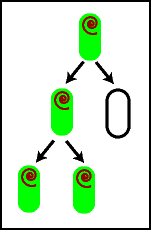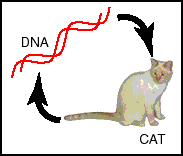|
|
What is making who?
Sparky the cat needed his DNA to build himself, with a little
help from his mother of course. If all the DNA in this adult were
to disappear in an instant, he could continue to drink milk and
chase mice. Sparky might think he could do without DNA, but in
a few days he would know better. There are several tissues, e.g.
blood and the endothelial layer of the intestine, that are continually
being replaced by replication of stem cells, and once DNA is gone,
that can't happen. As these short lived cells die out, he would
become sick and die, with symptoms similar to radiation sickness.
This is not coincidental, since a major effect of ionizing radiation
is destruction of DNA. Of course, without DNA he also can't have
children, and thus can't contribute to the species. If too many
cats loose their DNA the whole species dies out, and Sparky has
died in a very fundamental, existential way. |
|
|
The DNA needs the cat to protect it from a harsh environment,
and to supply energy for it to replicate. The fact that Sparky
is likely to mate with a female, thus forming cells containing
a mixture of DNA from the two cats means the DNA will populate
a varied group of children. This gives it a greater chance of
being inside a cat with characteristics that will insure its survival.
Is DNA making the cat, or is the cat making DNA? |
|



